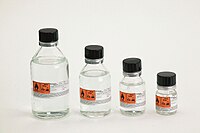
Photo from wikipedia
Abstract In the present and in the preceding article, the unimolecular fragmentation of the radical cations of 2-benzylindane and eleven derivatives bearing meta - or para -substituents at the benzylic… Click to show full abstract
Abstract In the present and in the preceding article, the unimolecular fragmentation of the radical cations of 2-benzylindane and eleven derivatives bearing meta - or para -substituents at the benzylic moiety have been studied with respect to the hydrogen exchange that precedes their fragmentation by the McLafferty reaction. Extensive regio- and stereospecific deuterium labelling confirmed that the hydrogen exchange involves the two cis -oriented H atoms at the benzylic C-1 and C-3 positions of the indanyl moiety and the two ortho -H atoms of the benzyl group. This 4-H exchange is perfectly stereoselective for the most electron-rich congeners [X = OCH 3 , N(CH 3 ) 2 and 3′,5′-(OCH 3 ) 2 ] but less stereoselective for the other analogs. Energy- and lifetime-dependent measurements with the deuterium-labelled isotopologs revealed that the extent of H/D exchange progresses with the ions’ lifetime much faster in the meta - than in the para -isomers. With exception of the meta -dimethylamino derivative, equilibration (complete scrambling) of the four H atoms is reached in the long-lived, metastable ions, whereas the para -dimethylamino isomer does not undergo any exchange at all. The relative rate of the H/D exchange is rationalized on the basis of the energy profiles calculated for the reversible γ-H transfer that generates the corresponding distonic arenium-ion intermediates and for the overall fragmentation by the McLafferty reaction. The ipso -protonolysis of the benzyl residue giving rise to the loss of the corresponding arenes specifically from some of the para -isomers was also found to reflect the regio- and stereoselective 4-H exchange.
Journal Title: International Journal of Mass Spectrometry
Year Published: 2017
Link to full text (if available)
Share on Social Media: Sign Up to like & get
recommendations!